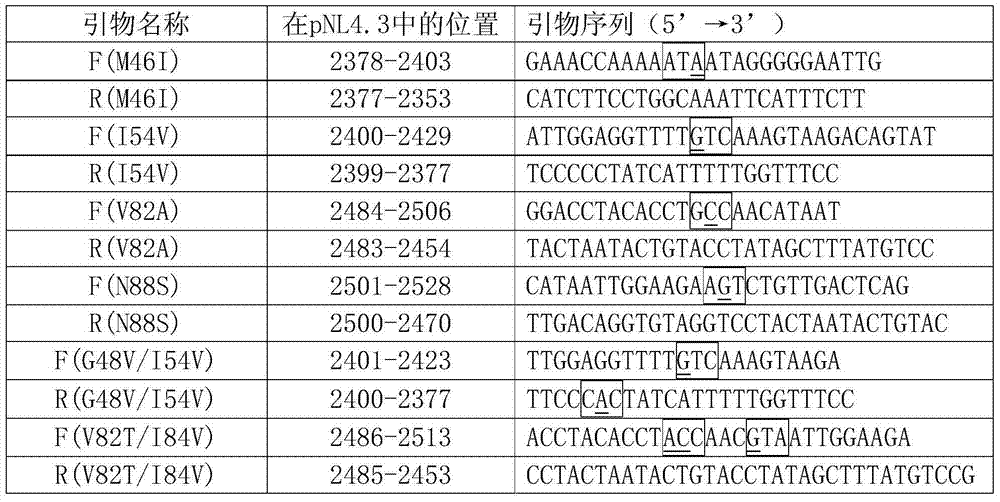Strain kit for screening and evaluating AIDS (acquired immune deficiency syndrome) therapeutic drugs
A technology of virus strains and kits, applied in the field of virus strain kits, can solve the problems of high toxicity and side effects, few varieties, and inability to meet clinical needs
- Summary
- Abstract
- Description
- Claims
- Application Information
AI Technical Summary
Problems solved by technology
Method used
Image
Examples
Embodiment 1
[0046] Embodiment 1, construction of recombinant plasmid
[0047] 1. Using the pNL4.3 plasmid as a template, the primer pair consisting of OUT-1315 and OUT-3525 was used for PCR amplification to obtain PCR amplification products.
[0048] 2. Using the PCR amplification product obtained in step 1 as a template, a primer pair consisting of IN-Sph I and IN-Age I is used for PCR amplification to obtain a PCR amplification product. After sequencing, the PCR amplification product is shown in the 1434th to 3514th nucleotides of Sequence 1 in the sequence listing.
[0049] 3. Ligate the PCR amplification product obtained in step 2 with the pMD18-T vector to obtain a recombinant plasmid.
[0050]4. Using the recombinant plasmid obtained in step 3 as a template, perform PCR amplification with a primer pair consisting of F(M46I) and R(M46I), and obtain recombinant plasmid M46I under the action of T4 DNA ligase. Because circular DNA is amplified, F(M46I) and R(M46I) amplify the sense st...
Embodiment 2
[0070] Embodiment 2, construct HIV mutant strain
[0071] 1. Suspend 293T cells in DMEM medium containing 10% fetal bovine serum (FBS) by volume to obtain 4×10 5 cells / ml of cell suspension.
[0072] 2. Add the cell suspension obtained in step 1 to a 6-well culture plate, 2ml per well, 37°C, 5% CO 2 Incubate for 24 hours.
[0073] 3. With the help 2000 (operated according to the instructions), transfect the cells of step 2 with the recombinant plasmid pNL4.3-M46I (transfection of 2.5 micrograms of recombinant plasmid per well), 37 ° C, 5% CO 2 After culturing for 36 hours, collect the culture supernatant, which is the HIV-M46I strain virus culture supernatant, and store at -80°C after aliquoting.
[0074] The above steps were carried out by using the recombinant plasmid pNL4.3-I54V instead of the recombinant plasmid pNL4.3-M46I to obtain the HIV-I54V strain virus culture supernatant.
[0075] The above steps were carried out by using the recombinant plasmid pNL4.3-V82A i...
Embodiment 3
[0081] Embodiment 3, the virus infectivity identification of mutant virus strain
[0082] The HIV-M46I strain virus culture supernatant prepared in Example 2, the HIV-I54V strain virus culture supernatant, the HIV-V82A strain virus culture supernatant, the HIV-M46I / N88S strain virus culture supernatant, the HIV-G48V / I54V strain Virus culture supernatant, HIV-M46I / V82T / I84V strain virus culture supernatant, HIV-G48V / I54V / V82A strain virus culture supernatant and HIV-1B subtype pNL4.3 wild strain virus culture supernatant were used as the virus culture supernatant to be tested. Clear, carry out the following identification respectively:
[0083] 1. Suspend TZM-bl cells in DMEM medium containing 10% FBS by volume to obtain 1.1×10 4 cells / ml of TZM-bl cell fluid.
[0084] 2. Add the cell suspension obtained in step 1 to a white 384-well plate, and add 90 μl to each well.
[0085] 3. Dilute the culture supernatant of the virus to be tested in a 3-fold gradient with DMEM culture ...
PUM
 Login to View More
Login to View More Abstract
Description
Claims
Application Information
 Login to View More
Login to View More - R&D Engineer
- R&D Manager
- IP Professional
- Industry Leading Data Capabilities
- Powerful AI technology
- Patent DNA Extraction
Browse by: Latest US Patents, China's latest patents, Technical Efficacy Thesaurus, Application Domain, Technology Topic, Popular Technical Reports.
© 2024 PatSnap. All rights reserved.Legal|Privacy policy|Modern Slavery Act Transparency Statement|Sitemap|About US| Contact US: help@patsnap.com










